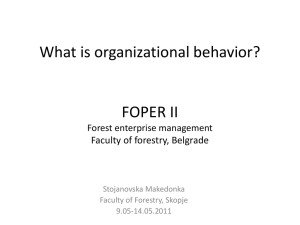Engaging Middle School Students through Career Exploration
advertisement
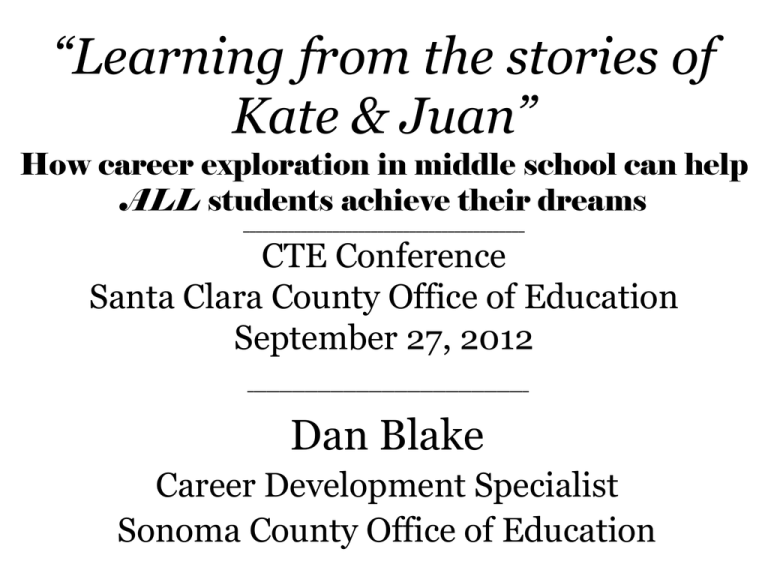
“Learning from the stories of Kate & Juan” How career exploration in middle school can help ALL students achieve their dreams ____________________________________________ CTE Conference Santa Clara County Office of Education September 27, 2012 ____________________________________________ Dan Blake Career Development Specialist Sonoma County Office of Education Kate & Juan are real students, and their stories are not unlike those of many students you work with every day Kate’s Story… Juan’s story… What can we learn from their stories? Sixth-through-ninth-grade children have demonstrated very little understanding of how school relates to the real world and seem to have little to no awareness of the skills and knowledge needed for success in the future. (Johnson, 2000) Without willing & motivated learners, all our best reform efforts will be in vain. Young people have high ambitions, expecting to be highly educated and have professional careers, yet research has found that many do not develop coherent plans for achieving their goals. (Hughes & Merchur Karp, 2004) Johns Hopkins University research suggests that “the extent to which students [in grades 5-8] believed that the mathematics they were studying would be useful in life…was the strongest predictor of student effort.” Guidance activities directed at junior high school students had the largest effect sizes, indicating that guidance efforts may be most effective with preteenage (rather than high school or college) students (Hughes & Merchur Karp, 2004) When surveyed, the majority of high school dropouts say they began to “disconnect” in middle school or earlier. (Castellano et al., 2002) Some alarming statistical trends: st 1 •The U.S. has fallen from th place to 13 in high school graduation rates th 12 •The U.S. now ranks in the percentage of 25-34 yearolds with an A.A. Degree or higher However, the U.S. does lead the world in one important statistic: The U.S. has the highest college dropout rate in the industrialized world. The number one reason students drop out of college is a lack of career focus. Even if they do stay in college, students who lack focus end up spending more time and money to earn a degree. With advance planning, [students] can enter college well-informed and focused on a career goal. (ACRN, 2006) If students have a clearer idea of their career goals, they will be more likely to engage in academic tasks. (Blustein, 2002) Career Development Continuum Preparing all Youth for Success in College, Career, and Life Career Awareness Career Exploration Career Preparation Learn about a wide variety of jobs and careers Explore, research, and plan for the future Gain education, training, and work experience Classroom & School • • • • • • Web Research Guest Speakers Career Interest Assessment College & Career Fairs Career Contextual Instruction College Awareness Workplace • Industry Tours & Field Trips • Career & Job Fairs • Youth in the Workplace Families & Neighborhood • Adult Interaction • Role Model Observation Classroom & School • • • • • • Career Pathways, Courses, & Clubs Integrated Curriculum Classroom Simulations Career Plan Development Career-Focused Projects & Assignments College Exploration Workplace • • • • Job Shadowing Career Mentoring Community Service Projects Informational Interviews Families & Neighborhood • Risk Taking • Role Playing • Progression of Responsibility K-8 School & Workplace • • • • • • • • • • • Core Academic Preparation Career Technical Courses & Programs Career-Related Project-Based Learning Career Plan Refinement Work-Ready Certification/Soft Skills Occupational Certifications Job-Seeking Skills Work Experience Internships College Preparation Postsecondary Options: • Community College • 4-year College or University • Trade/Technical School • Military Service/National Service • Apprenticeship • Enter Workforce (full or part time) • Self-Employment/Entrepreneur Exploration Engaged Experienced Aware Skilled Prepared Connected 9-16 Awareness Educated Preparation Current efforts… Too frequently, career preparation for middle grade students consists of a single, brief unit once a year. Ideally, career education and development should be infused into the curriculum. The most effective career development programs are systemic—developmental, accessible to all learners, and embedded in the curriculum as part of the whole process of educating a child for the larger thing called life. (Maddy-Bernstein & Dare, 1997) Program Goals & Objectives Expand knowledge of career options Program Goals & Objectives Expand knowledge of high school and post-secondary education/training options Program Goals & Objectives Increase perception of post-secondary relevance Program Goals & Objectives Increase understanding of career goals, interests, and aspirations Program Goals & Objectives Increase the number of students who develop integrated academic/career development plans, including course sequences that are consistent with career pathway options Program Goals & Objectives Increase awareness of middle school staffs & parents regarding career development resources and educational options Q & A: What does it look like? Key Curriculum & Activities Contact Information Dan Blake Career Development Specialist Sonoma County Office of Education 707-524-2780 dblake@scoe.org

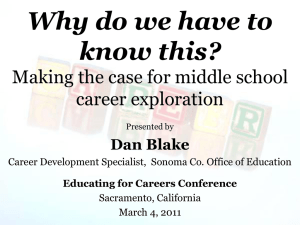

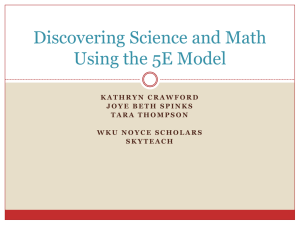


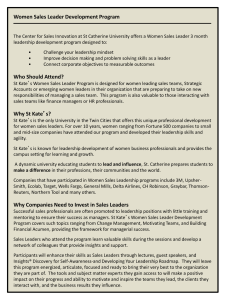
![The mysterious Benedict society[1]](http://s2.studylib.net/store/data/005310565_1-e9948b5ddd1c202ee3a03036ea446d49-300x300.png)



